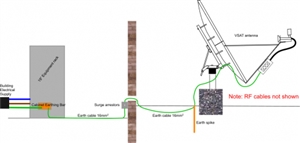


Brian_Bucket:
Zoomup
Thanks for the pointer I'll try the other forum. The supplies are mainly TT, but some very remote sites are powered by a local generator almost full time. The protective devices are usually RCDs. The earthing is to give some protection in case of lightning. However, if the location is very prone to electrical storms an air terminal on a near-by structure is usually also provided. This will have it's own earthing system. The dishes are usually ground based. The class of the power supply is difficult to determine as the indoor equipment comprises six or seven modules each with their own mains supply. The equipment mounted on the dish usually gets its power from the RF coax cables. However, sometimes the dish mounted amplifier (BUC) is 240v powered, either with an SWA cable run into the unit, or via a 240v ac/48v dc power supply mounted on the antenna mount.
Brian
Hello Brian, you will get some replies soon when the experts get back from the pubs and night clubs.
Z.
Brian_Bucket:
I am trying to apply the principles of BS 7671 to VSAT installations in Africa.
Being in an African country I assume that this is not South Africa where their "electrical building regulations" - https://store.sabs.co.za/catalog/product/view/_ignore_category/1/id/2142524/s/sans-10142-2-2018-ed-1-02-2/ are relevant and a copy in .pdf can be download at cost.
This document is the wiring of premises SOUTH AFRICAN NATIONAL STANDARD - The wiring of premises Part 1: Low-voltage installations.
I was familiar with the loose leaf, hard copy of SABS 0142, which is a forerunner of this document, it was largel based on BS7671 to start off with..
Search for a forum In RSA, there probably is one-
Jaymack
I am no expert but I think it would be better to have your surge arrestor on the earth outside the building rather than inside. Also I am not over keen in the long runs of earth from your surge arrestor to the earth electrode. I would be much happier to see another electrode directly connected to your surge arrestor outside the building. In the UK BS 7671 requires the total length of the connection of a live conductor to a Surge Protection Device and the earth connection ideally should not exceed 0.5m and not to exceed 1m.
We're about to take you to the IET registration website. Don't worry though, you'll be sent straight back to the community after completing the registration.
Continue to the IET registration site